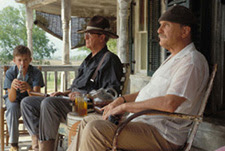Stupid, stupid, stupid!
As if the Boy Scouts of America didn't have enough public relations problems with its recent anachronistic ambivalence related to the involvement of gay Scouts and leaders, two of its Troop-level volunteers -- two out of more than one million adult leaders throughout the program -- stupidly toppled a 200-million-year-old rock formation in Utah's Goblin Valley AND more stupidly posted a video on Facebook that the Salt Lake City Tribune posted on YouTube.
Just in case the print story wasn't damaging enough, the video clarified any misunderstandings or hope for justification by vividly showing the leaders' -- oops, no leadership characteristics there -- the morons' testosterone-laced intent to vandalize the irreplaceable natural landmark, even grossly singing and dancing to the hip-hop tune, "Wiggle It" as the rock falls.
I fully understand the operational and public relations challenges that the Boy Scouts of America faces, especially related to matching its national face with its local "boots on the ground." I worked as a full-time, executive staff member for local offices of the Boy Scouts of America for 20 years.
I loved the work and most of the volunteer leaders I met and collaborated with to deliver quality programs to young people. I enjoyed opportunities that few of my social peers couldn't even imagine, from backpacking in the Rockies to having top-level corporate leaders follow my lead on fund-raising campaigns.
From a national perspective, the BSA is torn by its long-time partners -- mostly churches -- on the homosexuality issue, yet few can deny the positive impact of the program.
The results of a recent study by Baylor University showed that young men who attain Scouting's highest youth recognition, Eagle Scout, are more likely to have closer relationships with their friends and families and, as adults, to serve in leadership positions at their place of employment or in their communities, contribute to charitable organizations, and be goal-oriented and network with their peers. A visit to the BSA's website shows countless stories of young Scouts performing far beyond the expectations of their peers, many saving lives using skills only acquired through Scouting.
But the unit-level program is the core of the Scouting program. That's where young people reap the benefits of being in Scouting, and I remain amazed at the opportunities I've seen given to young people as a result of caring, role-model volunteer leadership.
On the other hand ... In 1988, when I was working for the Boy Scouts in Houston, the national organization opened the door to women to become Scoutmasters, a role limited only to men since the organization's founding in 1910. We arranged a media event at a local church for a TV station's to interview our area's first female Scoutmaster and to get feedback from other unit-level leaders and Scouts.
Most of the counter arguments to women as Scoutmasters focused on the need of young men to have male role models that could help shape their character, citizenship and personal fitness (BSA goals at the time). I vividly remember the video footage that accompanied these arguments: a slow scan of a group of pot-bellied male Scout leaders who'd spent more than their share of time sampling Dutch Oven cobblers (a camping delicacy). Good men, but visually in direct conflict with the BSA's stated goals.
And then there are those like the Goblin Valley duo. Every organization has them somewhere, just waiting for that stupid gene to launch them into the spotlight.
Interestingly, Fox13, a television news outlet in Salt Lake City, reported that the rock-topplers were on a church camp-out; however, most other new sources have focused on the men's Boy Scout connection and have reported that eight Scouts were with them. So, were the men on a sanctioned Boy Scout activity, or is the media focusing on the men's involvement with the Boy Scouts of America and its close tie to outdoor stewardship to give one more swift (but lingering) kick to a stumbling organization?
How much control can an non-profit organization the size of the Boy Scouts of America have over the 24/7 actions of its volunteers? More importantly, do organizations like the Boy Scouts of America, when failing to take a relevant and firm stand on societal issues, hurt themselves and the beneficiaries of their services more? And are those organizations painting a target on their backs by the mishandling of the larger public relations challenges and then enduring harsher media response as a result of localized issues?
The BSA is managing this episode as well as can be expected at this point, and I think they're headed in the right direction. Here's the official statement, as posted on the local office's website serving the Goblin Valley area (and not found on the national BSA site):
In regards the recent incident in Goblin Valley, the Utah National Parks Council releases the following statement:
We are shocked and disappointed by this reprehensible behavior. For more than a century, the Boy Scouts of America has been a leader in conservation—from stewardship to sustainability. We teach our 2.6 million youth members and 1.1 million adult members, who collectively spend more than 5.5 million nights outdoors, the principles of “Leave No Trace.” These principles stress a commitment to maintaining the integrity and character of the outdoors and all living things.
The isolated actions of these individuals are absolutely counter to our beliefs and what we teach. We are reviewing this matter and will take appropriate action.
On background, for additional information about what Scouting teaches, please visit: http://www.scouting.org/scoutsource/boyscouts/teachingleavenotrace.aspx.
Just as an aside ...
I think the Boy Scouts of America will allow openly gay adults to become volunteer leaders. In a similar environment, it won a case to prevent women from becoming Scoutmasters in 1987, but reversed its stance in 1988, I'm thinking, to acknowledge the changing needs of our society and to better serve more young people.
The same logic will prevail, and the BSA will take a hit from its chartered partners (local "sponsors" like churches, civic clubs, etc.). But if it stays the course and maintains focus on its core mission, it will survive, even with abandonment by more conservative churches (probably not the BSA's staunchest supporters for most of its history anyway) and the onslaught of Scouting "alternatives" (that I won't link to because I want no association).
If it doesn't, it's dead.
Follow me on Twitter: @FWgib
Sunday, October 20, 2013
Can toppling a rock topple an organization?
Subscribe to:
Post Comments (Atom)


No comments:
Post a Comment